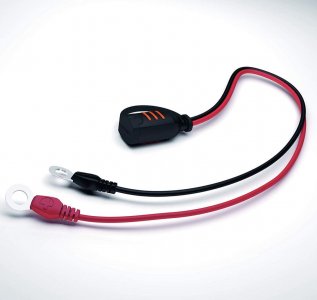With NC1, there is a factory pre-wired connector inside the cabin behind the passenger side 'Under cover'.
The OEM conditioner comes with the 'Indicator harness' and one end would plug into this factory pre-wired connector (2pin).
The other end has panel mounted CTEK receptacle connector (with LED indicator, I think).
Similar to their aftermarket accessory cable product called 'Indicator Panel (1.5m, 3.3m)'.
You need to cut small square out of the Under cover to mount thia Indicator panel.
In order to finalise the electrical circuit, you will need to insert the 10A fuse (included in the OEM conditioner kit) at the specific position inside the subfuse box located just behind the same passenger Under cover.
So, from the functionality point of view and as many people mentioned above, it would be far easier to just get the ordinary CTEK conditioner and use the eyelet cable included in the kit directly at the battery or at the jump start terminal in the eng bay.
I installed eyelet cable at both locations on my NSX.
If you really-really want copying the NC1 method, I think you can do the followings.
If you can't understand what I mentioned or didn't bother reading to the end, you already made the choice.
Just go with the proven ordinary method.
Please double check the position of the connector and the fuse socket mentioned below.
It could be different depending on the year model and the country spec.
1. Locate the fuse box (panel) at the passenger footwell.
2. At the very top row, you will see 4 x 1pin 250 size terminals.
They are for the optional purpose so all or most of them should be empty.
3. Looking at the panel from left to right, they are Lighting SW, IG2, BAT and ACC.
4. You need to connect the battery conditioner to the +B BAT but unless you insert the appropriate fuse at the Main fuse box inside the eng bay (mentioned later), it won't be live.
5. You need to establish the connection between the 2pin end of the OEM indicator harness and the +B BAT terminal at the passenger fuse panel & nearby GND.
6. Create DIY adaptor loom if you don't want modifying the OEM indicator harness or just modify it.
The 1pin 250 size terminal is Sumitomo HD series non-WPC 250 1pin.
7. Mount the panel side of the OEM indicator harness somewhere at the passenger lower cover panel under the glove box.
It's plastic so should be able to cut it out in suitable size.
8. Insert the 10A fuse included in the OEM conditioner kit at the Main fuse box inside the eng bay.
Please check the position depending on the year model and the country spec.
On mine (94, JDM), it was next to the rear defogger relay.
9. Use multimeter to confirm that you can see battery voltage at the Indicator panel that you just installed.
Depending on the condition of your battery, the single LED at the panel may change the colour (sorry, I don't have access to the actual OEM indicator harness so can't confirm this).
10. Once you are happy with the reading of the multimeter, connect the conditioner.
11. If wired properly and the polarity at the correct orientation, the conditionor should start the diagnosis and conditioning process.
12. Don't forget to disconnect the battery conditionor before leaving the garage especially if you are running the cable under the passenger door.
I normally place caution plate on the steering wheel and the shift lever to remind me and also in case someone decides to move the car.
Good luck.
Kaz








